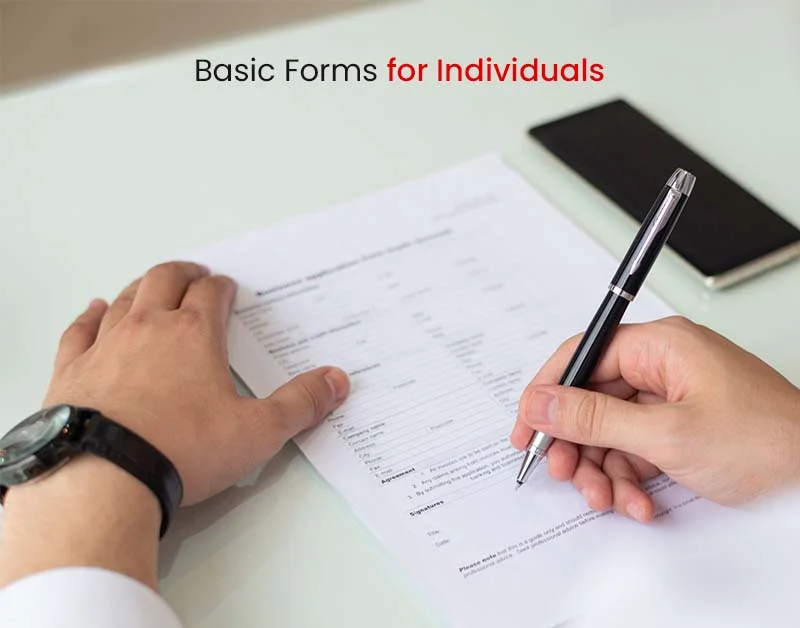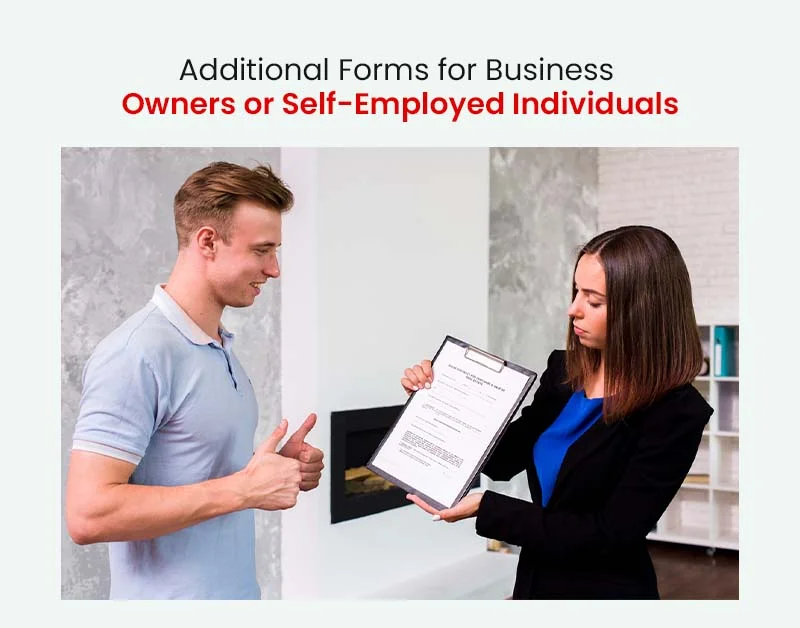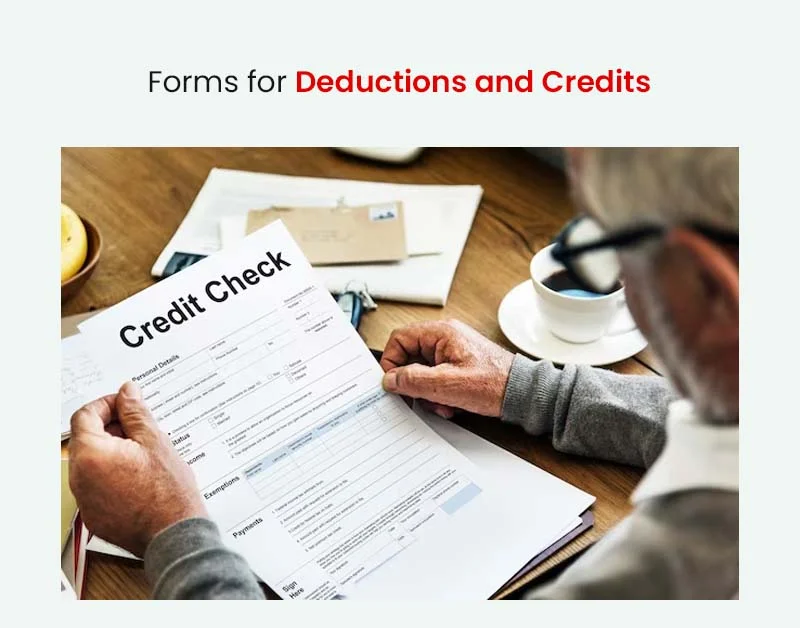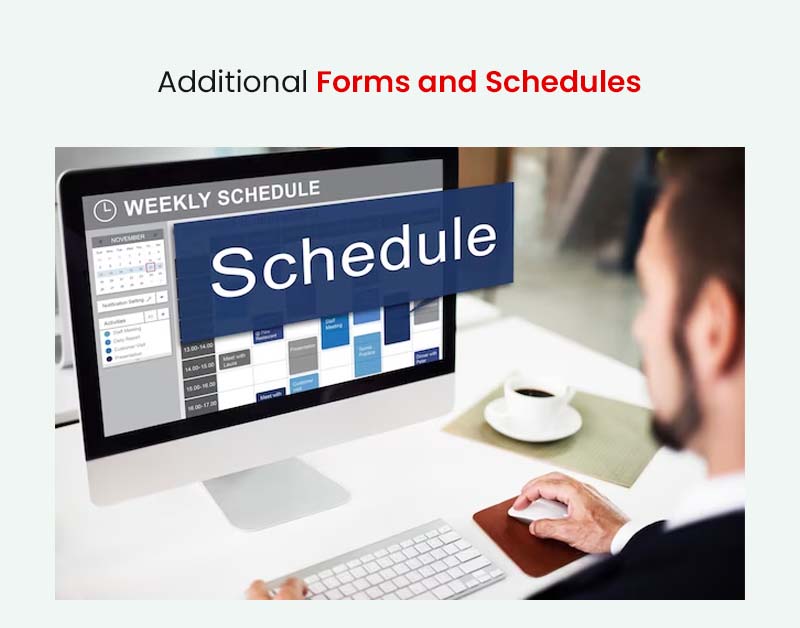In 2023, filing tax forms accurately and on time will be necessary to meet legal requirements and maximize potential returns. Understanding which forms for taxes or papers to file taxes are required for your financial circumstances to prosper this tax season is critical.
This blog will offer essential information about the best way to file taxes for 2023 and the documents you may need to fill out the tax form. This will allow you to keep organized and ensure a seamless tax filing procedure.
This blog will help you find the information needed to file taxes to meet your tax obligations, whether you are an individual taxpayer, a business owner, or have a particular financial situation.
Key Takeaway:
- Accurate and timely tax filing is critical to meet legal requirements and optimize returns in 2023.
- Knowing which tax forms relate to your case is crucial for a hassle-free tax filing experience.
- Individual tax forms include a list of tax forms 1040, 1040-SR, 1040-ES, W-2, and numerous 1099s.
- Forms needed for taxes to Business owners require forms like 1065, 1120, and Schedule C.
- Conditions such as 1098, 2441, 8917, and 8863 are frequently used for deductions and credits.
- Keeping meticulous records and engaging with tax professionals can help assure accurate tax returns and significant savings.
- Various schedules and forms are available to adapt to certain tax situations and must be used correctly.
- Keep up with the newest tax law changes and check IRS resources for the most up-to-date information.
Basic Forms for Individuals

Here’s a step-by-step breakdown of the primary individual tax file forms you’ll need to file your 2023 tax return:
Form 1040
The standard individual income tax return form used in the United States is Form 1040. Taxpayers use it to record their annual income, calculate tax liability, and claim deductions and credits.
Form 1040-SR
Form 1040-SR is developed exclusively for people over the age of 65. It is similar to Form 1040 but with larger lettering and a more straightforward style to help senior people. This simplifies the reporting of income, deductions, and tax credits for seniors.
Form 1040-ES
If you receive income not subject to withholding, the “Estimated Tax for Individuals” form, Form 1040-ES, is used to calculate and pay estimated taxes. This form assists you in making quarterly payments to satisfy your income tax liability, such as self-employment earnings, dividends, or rental income.
Form W-2
Form W-2, often known as the “Wage and Tax Statement,” is supplied by your employer. It shows your annual earnings, salary, and the taxes withheld from your paycheck during the financial year. This form must appropriately declare your earned income on your tax return.
Form 1099
Form 1099 reports non-employer income received throughout the tax year (e.g., 1099-INT for interest income, 1099-DIV for dividend income, and 1099-MISC for miscellaneous income). Income through investments, freelance work, or contract jobs are examples.
All the above income tax filing forms are very crucial in tax returns. Form 1040 and its variants (for example, 1040-SR and 1040-ES) are used to report your income, deductions, and credits accurately.
Form W-2 summarizes your earned income and taxes withheld. In contrast, multiple 1099 forms assist you in reporting extra sources of revenue. Form 1040-ES must make anticipated tax payments throughout the year and avoid underpayment penalties.
Additional Forms for Business Owners or Self-Employed Individuals

Additional simple tax forms that business owners or self-employed individuals may need to be aware of and possibly submit in 2023 include the following:
Form 1065
Partnerships utilize Form 1065 to report their income, deductions, gains, and losses. On the other hand, partnerships do not pay income taxes; instead, income and losses accrue to individual partners, who record them on their tax returns.
Form 1065 facilitates the distribution of these funds among the partners and gives information on the partnership’s financial activity.
Form 1120
Corporations (C corporations) use Form 1120 to report their income, deductions, and taxes payable to the IRS. Profits earned by C businesses are subject to corporate income tax, and Form 1120 is used to assess and record this tax due.
Schedule C
Schedule C is an attachment to Form 1040 used by sole proprietorships and single-member LLCs to report business income and expenses. This form assists in calculating the company’s net profit or loss, which is then reported on Form 1040 for the individual.
Form 990
Tax-exempt organizations, such as nonprofits, charities, and religious institutions, must file Form 990. It details the organization’s finances, operations, and tax-exempt status. The size and kind of organization determine the specific version of Form 990 required.
Self-employed individuals and business owners should carefully assess which forms apply to their situation. To report partnership revenue, use Form 1065, corporations use Form 1120, and sole owners or single-member LLCs use Schedule C.
Tax-exempt nonprofit organizations primarily use tax filing papers such as Form 990 under Section 501(c) of the Internal Revenue Code to report financial information to the IRS.
Forms for Deductions and Credits

Here are all tax forms to file taxes that individuals may need to use for deductions and credits on their tax returns in 2023:
Form 1098
Mortgage lenders produce Form 1098, which indicates the mortgage interest paid throughout the tax year. Individuals who want to claim the mortgage interest deduction on their tax return must have this information. It also includes information such as property taxes and mortgage insurance costs.
Form 2441
The Child and Dependent Care Credit is claimed using Form 2441. This form assists in calculating the credit you may be eligible for if you paid for childcare or dependent care expenses to enable you (and your spouse if filing jointly) to work or look for a job. It needs you to supply information about the caregiver and the costs incurred.
Form 8917
The Tuition and Fees Deduction allows qualifying taxpayers to deduct qualified education expenses such as tuition and related fees for themselves, their spouses, or dependents. Form 8917 is used to file it. Higher education students must minimize their taxable income.
Form 8863
Form 8863 claims education credits on your federal tax return, such as the American Opportunity Credit or Lifetime Learning Credit. It necessitates precise reporting of qualified education expenses.
These forms are essential in assisting individuals in lowering their taxable income or taking advantage of tax breaks that can result in possible tax savings.
It is critical to ensure that you meet the eligibility requirements for the deductions and credits you desire to claim and have the relevant evidence to support your claims.
By appropriately getting tax form 8963, you can take advantage of these tax savings options while ensuring tax compliance.
Additional Forms and Schedules
In addition to the type of tax forms indicated above, individuals may need to file additional forms and schedules with their tax returns in 2023, depending on their financial position. Here are a few more records and programs:
Schedule A – Itemized Deductions
Schedule A includes medical bills, state and local taxes, mortgage interest, and charitable contributions. Taxpayers can choose between taking the standard deduction and itemizing deductions to reduce their tax liability.
Schedule B – Interest and Ordinary Dividends
Schedule B reports interest and dividend income. You may be required to file this schedule if you earned more than a specific interest or dividends during the tax year.
Schedule D – Capital Gains and Losses
The capital gains and losses from the sale of assets such as stocks, bonds, and real estate are reported on Schedule D. It aids in calculating net capital gain or loss, which may have tax implications.
Schedule E – Supplemental Income and Loss
Schedule E reports rental property income and losses, partnerships, S companies, and other types of pass-through revenue. It details the numerous sources of revenue and expenses associated with these investments.
Schedule F – Profit or Loss from Farming
Farmers use Schedule F to report revenue and costs connected to their farming activity. It is critical for people interested in agricultural projects.
Form 6251 – Alternative Minimum Tax
The Alternative Minimum Tax (AMT) is calculated using Form 6251. The AMT is a separate tax system meant to ensure that higher-income persons pay a minimum level of tax.
Form 8889 – Health Savings Accounts (HSAs)
Form 8889 reports contributions to and withdrawals from Health Savings Accounts, which provide tax breaks for eligible medical expenses.
Form 8606 – Nondeductible IRAs
Form 8606 is used to report nondeductible contributions to conventional IRAs and to track basis when making distributions from traditional IRAs.
Form 8962 – Premium Tax Credit
The Premium Tax Credit, which helps individuals and families with low to moderate incomes afford health insurance acquired through the Health Insurance Marketplace, is calculated and reconciled using Form 8962.
Form 8965 – Health Coverage Exemptions
Form 8965 requests exemptions from the individual shared responsibility payment (the penalty for not having health insurance) and report any exemptions the Marketplace granted.
Unlock your ERC potential with an R&R Agency.

R&R Agency will help you reclaim what is rightfully yours! We excel in simplifying the complex Employee Retention Tax Credit (ERTC) application process.
Many CPAs avoid it owing to its complexity, but our experienced team makes it simple for your company. Don’t put off talking to our experts about your ERC eligibility. We are your reliable partner for all things ERC, delivering a stress-free experience.
Contact us now, and Let’s Get your ERC credits as soon as possible and as smoothly as possible!
FAQs
Gather critical documents such as W-2 (for job income), 1099 (for multiple sources of income), Form 1040 (individual income tax return), relevant schedules of deductions or credits, bank statements, and investment statements to meet IRS tax responsibilities.
If you work for yourself or own a business, keep track of your income and expenses. Keep receipts and invoices as documentation of deductions.
Maintain the organization of all tax-related papers to ensure smooth and accurate filing of taxes in 2023 and compliance with the IRS requirements. It may make sense to consult a tax expert in difficult financial situations.
It is critical to locate your tax forms to file your taxes correctly. To begin, check your mailbox for W-2s, 1099s, and other mailing paperwork—access digital copies through the websites of your workplace or financial institution.
Obtain prior-year tax returns for future reference. Gather business income and cost records if you are self-employed. Gather receipts and related paperwork for deductions. Use tax preparation software or visit a tax specialist to guarantee you have all relevant forms.
The IRS also makes certain tax documents, such as transcripts, available online. Organizing these documents improves tax filing efficiency and reduces errors.
Form 1040-EZ is the most basic tax form for most individuals, albeit it has not been used since the 2017 tax year. Since then, the standard Form 1040 has been simplified for ease of use.
Form 1040 is generally straightforward for persons with simple sources of income, few deductions, and no problematic tax circumstances, according to my most recent knowledge update in September 2021.
However, tax regulations and forms are subject to change. As a result, it is best to visit the IRS website or a tax professional for the most up-to-date guidance on the simplest form to file.
Several crucial papers and documentation are generally required before filing taxes for 2023. W-2s (for job income), 1099s (for other income sources), and any other income documents, such as investment statements and records of deductible costs, fall into this category.
You’ll also need your Social Security Number (SSN) or Taxpayer Identification Number (TIN) and the previous year’s tax return.
Depending on your financial status, you may also require certain tax forms, such as Form 1040, together with necessary schedules and supporting evidence. The organization of these forms is critical for a seamless tax filing process.
To potentially improve your tax refund:
- Check if you qualify for and claim all appropriate deductions, such as mortgage interest, charity contributions, and medical costs.
- If qualified, take advantage of tax advantages such as the Earned Income Tax Credit (EITC) and the Child Tax Credit.
- Contributions to retirement plans, such as a 401(k) or IRA, should be maximized to reduce taxable income.
- Adjust your tax withholding to match your actual tax liability to avoid overpayments throughout the year.
- Seek the assistance of a tax professional for tailored ways to maximize your refund while remaining legal
While most deductions require receipts, some conclusions may be authorized without them, provided you fulfill specific criteria. The IRS may accept estimated expenses for charitable gifts under $250, but documented verification is preferred.
Taxpayers can use a standard deduction rate for certain business expenditures, such as mileage, without keeping track of individual receipts.
However, it is typically best practice to retain detailed records and receipts to verify deductions in case of an IRS audit or inquiry, as the taxpayer bears the burden of proof.
Conclusion
In conclusion, the best way to get taxes done in 2023 necessitates a complete comprehension of the tax forms applicable to your financial circumstances. Individuals should have the Form 1040 series, Form W-2, and 1099 documents.
Forms such as Form 1065 and Form 1120 and schedules such as Schedule C may be required by business owners. Deductions and credits may necessitate using conditions such as 1098, 2441, 8917, and 8863.
These documents must be filed accurately and on time to comply with tax rules, maximize potential refunds, or minimize tax liabilities. It is best to consult with a tax professional like R&R Agency for complex situations or fill out tax forms online.



